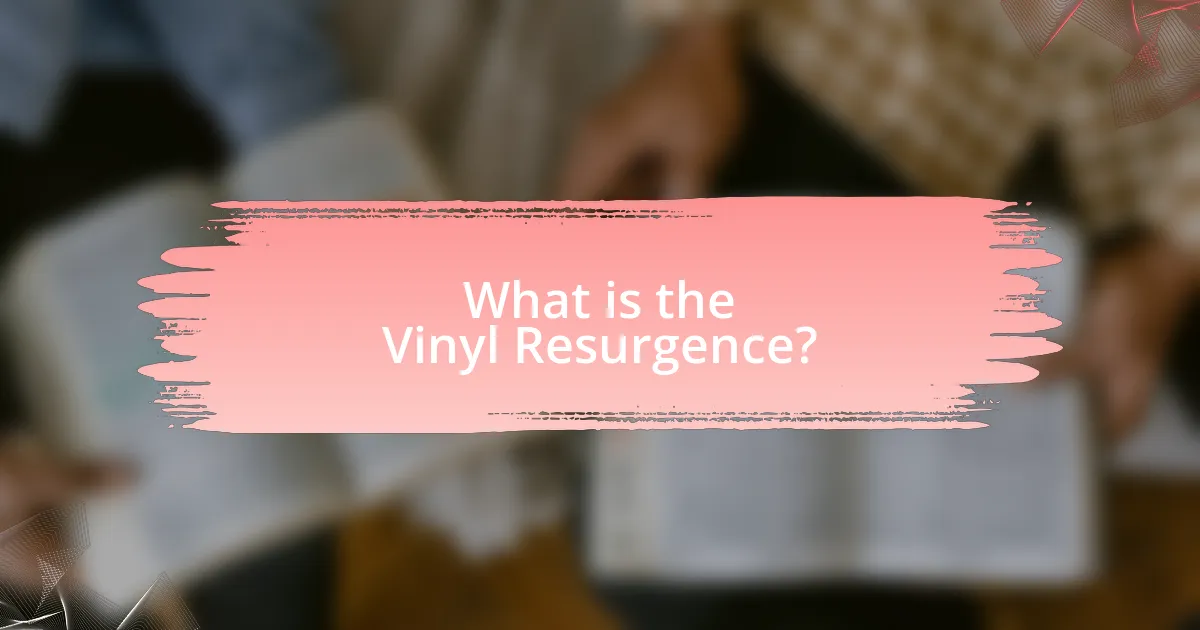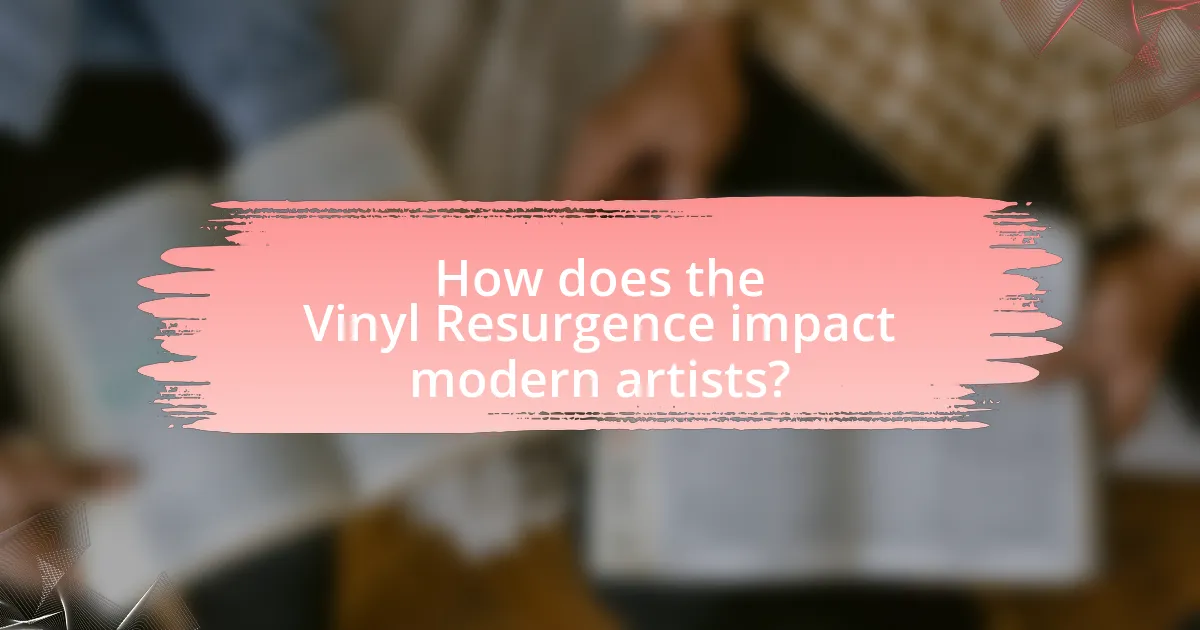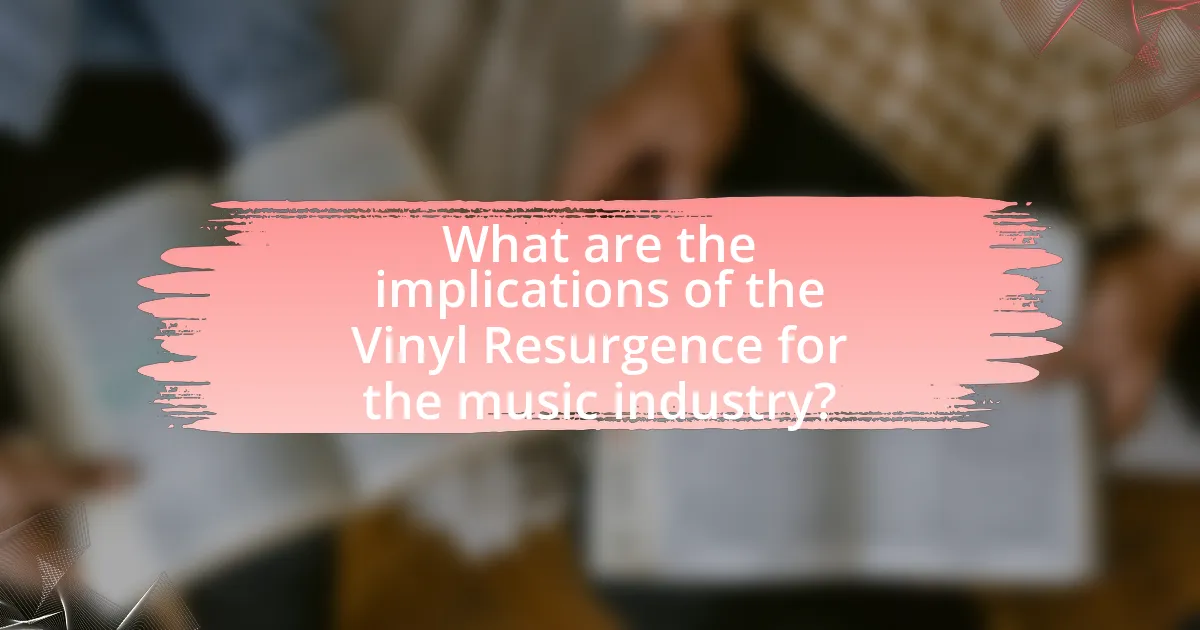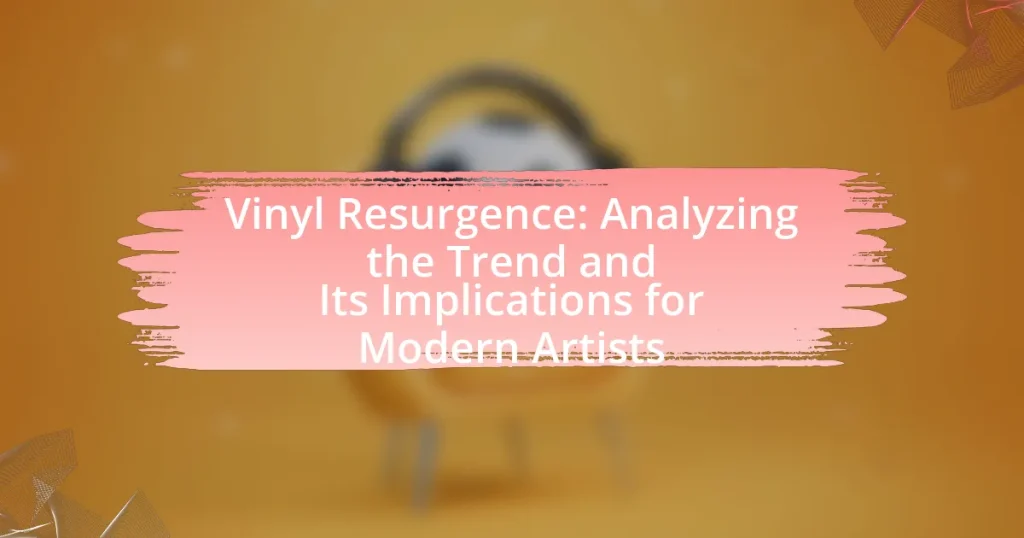The Vinyl Resurgence refers to the significant revival of vinyl record sales and interest in analog music formats, which began in the early 2000s and gained momentum, particularly evident when vinyl sales surpassed CD sales in the U.S. for the first time in 2020. This trend is driven by factors such as the tactile experience of vinyl, the appeal of album artwork, and a growing appreciation for analog sound quality. The article explores the cultural factors contributing to this resurgence, the impact on modern artists, and the challenges they face in production and distribution. Additionally, it examines the implications of the vinyl revival for the music industry, including demographic shifts among buyers and future trends in the vinyl market.

What is the Vinyl Resurgence?
The Vinyl Resurgence refers to the significant revival of vinyl record sales and interest in analog music formats that began in the early 2000s and has continued to grow. This trend is evidenced by the fact that vinyl sales in the United States surpassed CD sales for the first time in 2020, with over 27.5 million vinyl records sold, according to the Recording Industry Association of America (RIAA). The resurgence is driven by factors such as the tactile experience of vinyl, the appeal of album artwork, and a growing appreciation for analog sound quality among music enthusiasts and collectors.
Why has vinyl become popular again in recent years?
Vinyl has become popular again in recent years due to a resurgence in consumer interest for analog sound quality and the tangible experience of physical media. This trend is supported by statistics showing that vinyl sales in the United States surpassed CD sales for the first time in 2020, with the Recording Industry Association of America reporting that vinyl accounted for 27% of all physical music sales. Additionally, the aesthetic appeal of album artwork and the ritual of playing records contribute to its renewed popularity among both older generations and younger listeners seeking a nostalgic experience.
What cultural factors contribute to the vinyl revival?
The vinyl revival is primarily driven by a cultural appreciation for analog music formats, nostalgia, and the tactile experience associated with vinyl records. This resurgence reflects a desire for authenticity in music consumption, as many listeners seek a more immersive and tangible connection to their favorite artists. According to the Recording Industry Association of America (RIAA), vinyl sales have seen a significant increase, with revenue surpassing CD sales for the first time since the 1980s, indicating a strong cultural shift towards this medium. Additionally, the rise of independent record stores and vinyl-centric events fosters community engagement, further solidifying vinyl’s place in contemporary music culture.
How does nostalgia play a role in the resurgence of vinyl?
Nostalgia significantly contributes to the resurgence of vinyl by evoking emotional connections to past experiences and memories associated with music. This emotional appeal is evidenced by a 2020 report from the Recording Industry Association of America, which noted that vinyl sales reached a 30-year high, with many consumers citing a desire to relive the tactile and auditory experiences of their youth. The physicality of vinyl records, including album artwork and the ritual of playing a record, enhances this nostalgic experience, making it more appealing compared to digital formats.
What are the key characteristics of the vinyl resurgence?
The key characteristics of the vinyl resurgence include a significant increase in vinyl record sales, a growing appreciation for analog sound quality, and a cultural shift towards nostalgia and physical media. In 2020, vinyl sales in the United States surpassed CD sales for the first time since the 1980s, with over 27.5 million vinyl records sold, according to the Recording Industry Association of America (RIAA). This trend reflects consumers’ desire for a tangible music experience, as vinyl records offer a unique auditory quality that digital formats often lack. Additionally, the resurgence is marked by the rise of independent record stores and the popularity of vinyl among younger generations, who seek authenticity and a connection to music history.
How does the quality of sound compare to digital formats?
The quality of sound in vinyl records is often perceived as superior to that of digital formats due to its analog nature, which captures a wider range of frequencies and nuances. Vinyl records can reproduce sound waves in a continuous form, allowing for a richer and warmer audio experience, while digital formats typically sample sound at discrete intervals, which can lead to a loss of detail. Studies have shown that many listeners prefer the sound of vinyl for its depth and warmth, with a 2018 survey indicating that 70% of respondents believed vinyl provided a more authentic listening experience compared to digital formats.
What unique features do vinyl records offer to collectors?
Vinyl records offer collectors unique features such as tangible artwork, superior sound quality, and a nostalgic experience. The large format of vinyl allows for intricate cover art and packaging, which enhances the aesthetic appeal and provides a collectible aspect that digital formats lack. Additionally, vinyl records are known for their analog sound quality, which many audiophiles argue provides a warmer and richer listening experience compared to digital formats. This sound quality is often attributed to the physical grooves on the record that capture sound waves in a way that digital compression cannot replicate. Furthermore, the act of playing a vinyl record involves a ritualistic experience, from selecting the record to placing the needle, which fosters a deeper connection to the music. Collectors often seek out rare pressings, colored vinyl, and limited editions, adding to the uniqueness and value of their collections.

How does the Vinyl Resurgence impact modern artists?
The Vinyl Resurgence positively impacts modern artists by providing them with a unique platform to reach audiences and enhance their artistic expression. This trend has led to a significant increase in vinyl sales, with the Recording Industry Association of America reporting that vinyl sales surpassed CD sales in 2020 for the first time since the 1980s. As a result, artists are increasingly releasing their music on vinyl, which not only allows for higher profit margins but also fosters a tangible connection with fans through collectible formats. Additionally, the resurgence encourages artists to invest in album artwork and packaging, enhancing the overall aesthetic experience of their music.
What opportunities does vinyl provide for contemporary musicians?
Vinyl provides contemporary musicians with unique opportunities for artistic expression, revenue generation, and audience engagement. The resurgence of vinyl has led to a significant increase in sales, with vinyl records surpassing CD sales in the U.S. for the first time since the 1980s, indicating a strong market demand. This trend allows musicians to create limited edition releases, enhancing their brand and attracting collectors. Additionally, the tactile nature of vinyl and its associated nostalgia fosters a deeper connection between artists and fans, encouraging live performances and merchandise sales. The vinyl format also offers musicians a platform to showcase their artwork and storytelling in a physical medium, which can enhance their overall artistic identity.
How can artists leverage vinyl sales for revenue?
Artists can leverage vinyl sales for revenue by producing limited edition releases and merchandise bundles that appeal to collectors. The resurgence of vinyl, with sales reaching 41 million units in the U.S. in 2022, indicates a strong market demand. By creating unique vinyl products, such as colored records or autographed copies, artists can attract dedicated fans willing to pay a premium. Additionally, artists can enhance revenue through direct-to-consumer sales at concerts and online platforms, bypassing traditional retail margins. This strategy not only increases profit margins but also fosters a deeper connection with fans, as they often value the tangible experience of owning vinyl records.
What role does vinyl play in an artist’s branding and image?
Vinyl plays a significant role in an artist’s branding and image by serving as a tangible representation of their music and aesthetic. The resurgence of vinyl has allowed artists to create a unique identity that resonates with fans, as physical records often embody a sense of nostalgia and authenticity. According to the Recording Industry Association of America, vinyl sales reached a 30-year high in 2020, indicating a strong consumer preference for this format, which artists leverage to enhance their brand visibility and connect with audiences on a deeper level. Additionally, limited edition vinyl releases can create exclusivity, further solidifying an artist’s image and fostering a dedicated fanbase.
What challenges do modern artists face with vinyl production?
Modern artists face several challenges with vinyl production, including high manufacturing costs, limited pressing capacity, and supply chain disruptions. The cost of producing vinyl records can be significantly higher than digital formats, often exceeding $1,000 for a small run of records, which can be prohibitive for independent artists. Additionally, the resurgence in vinyl popularity has led to increased demand, resulting in longer wait times for pressing services, sometimes extending to several months. Furthermore, the global supply chain issues, particularly in sourcing raw materials like PVC, have exacerbated delays and increased prices, making it difficult for artists to plan releases effectively.
How does the cost of vinyl production affect independent artists?
The cost of vinyl production significantly impacts independent artists by limiting their ability to produce and distribute physical copies of their music. High production costs, which can range from $1,000 to $5,000 for a small run of records, create financial barriers that many independent artists struggle to overcome. This financial strain can lead to fewer releases, reduced marketing efforts, and ultimately, diminished visibility in a competitive market. Additionally, the rising demand for vinyl has led to longer turnaround times and increased prices, further complicating the situation for independent musicians who rely on physical sales for income.
What logistical issues arise in distributing vinyl records?
Logistical issues in distributing vinyl records include challenges related to manufacturing delays, transportation difficulties, and inventory management. Manufacturing delays often arise due to the limited number of pressing plants, which can lead to longer lead times for production. Transportation difficulties can occur due to the fragility of vinyl records, requiring careful handling and specialized packaging to prevent damage during shipping. Additionally, inventory management becomes complex as demand fluctuates, necessitating accurate forecasting to avoid overproduction or stockouts. These factors collectively complicate the distribution process for vinyl records, impacting availability and delivery timelines.

What are the implications of the Vinyl Resurgence for the music industry?
The Vinyl Resurgence has significant implications for the music industry, primarily by revitalizing physical music sales and enhancing artist revenue streams. In 2022, vinyl sales in the United States surpassed CD sales for the first time since the 1980s, with vinyl accounting for 41 million units sold, according to the Recording Industry Association of America (RIAA). This shift indicates a growing consumer preference for tangible music formats, which can lead to increased profits for artists through higher-margin sales of vinyl records compared to digital downloads or streaming. Additionally, the resurgence fosters a deeper connection between artists and fans, as vinyl often includes unique artwork and liner notes, enhancing the overall music experience. This trend also encourages independent labels and artists to produce limited edition releases, further driving sales and engagement within niche markets.
How has the vinyl revival influenced music consumption trends?
The vinyl revival has significantly influenced music consumption trends by driving a resurgence in physical music sales, particularly among younger audiences. In 2022, vinyl records accounted for 41% of all physical music sales in the United States, surpassing CD sales for the first time since the 1980s, according to the Recording Industry Association of America (RIAA). This trend indicates a shift towards tangible music formats, as consumers increasingly seek the tactile experience and aesthetic appeal of vinyl records. Additionally, the revival has fostered a culture of collecting and appreciation for album artwork and sound quality, further enhancing the value of physical media in an era dominated by digital streaming.
What demographic shifts are evident in vinyl buyers?
Vinyl buyers are increasingly younger, with a significant rise in interest among millennials and Gen Z. According to a 2021 report by the Recording Industry Association of America (RIAA), vinyl sales among consumers aged 18-34 accounted for nearly 50% of total vinyl sales, indicating a shift from the traditional older demographic that previously dominated the market. This trend reflects a broader cultural revival of analog formats, driven by nostalgia and the unique tactile experience vinyl offers, appealing to younger audiences who value authenticity in music consumption.
How does vinyl sales data compare to digital streaming statistics?
Vinyl sales data shows a significant resurgence, with sales reaching 41 million units in the U.S. in 2022, while digital streaming statistics indicate over 1 trillion streams on platforms like Spotify in the same year. This stark contrast highlights that while vinyl sales are growing, they still represent a fraction of the overall music consumption, which is dominated by digital streaming. The Recording Industry Association of America reported that vinyl sales accounted for approximately 13% of total music revenue, compared to streaming, which made up about 83%. This data underscores the trend of vinyl as a niche market, appealing to collectors and audiophiles, while digital streaming remains the primary mode of music consumption for the majority.
What future trends can we expect in the vinyl market?
The vinyl market is expected to continue its growth trajectory, driven by increasing consumer interest in analog sound quality and collectible formats. Sales of vinyl records reached 41 million units in the U.S. in 2022, marking the highest figure since 1991, according to the Recording Industry Association of America (RIAA). This trend is likely to persist as younger generations discover vinyl through social media and streaming platforms, leading to a resurgence in both new releases and reissues of classic albums. Additionally, advancements in vinyl manufacturing technology and eco-friendly production methods are anticipated to enhance the appeal of vinyl records, catering to environmentally conscious consumers.
How might technology impact the production and distribution of vinyl?
Technology significantly impacts the production and distribution of vinyl by enhancing manufacturing efficiency and expanding market reach. Advanced digital tools streamline the vinyl pressing process, allowing for quicker turnaround times and improved sound quality through precision engineering. For instance, modern cutting machines utilize computer-controlled systems that ensure consistent quality and reduce waste, which is crucial given the resurgence in vinyl popularity, with sales reaching 41 million units in the U.S. in 2022, according to the Recording Industry Association of America. Additionally, online platforms facilitate direct-to-consumer sales, enabling independent artists to distribute their vinyl records globally without traditional retail barriers, thus democratizing access to the market.
What innovations are emerging in vinyl record design and packaging?
Innovations in vinyl record design and packaging include the use of eco-friendly materials, intricate artwork, and enhanced audio quality features. Eco-friendly packaging options, such as biodegradable sleeves and recycled materials, are becoming more prevalent as artists and labels aim to reduce their environmental impact. Additionally, advancements in printing technology allow for more vibrant and detailed cover art, often incorporating unique textures or holographic elements. Enhanced audio features, such as colored vinyl and picture discs, not only appeal visually but also provide a tactile experience that enhances the overall enjoyment of the record. These trends reflect a broader movement within the music industry to create collectible items that resonate with both aesthetic and environmental values.
What best practices should modern artists consider when engaging with the vinyl market?
Modern artists should prioritize high-quality production and unique packaging when engaging with the vinyl market. High-quality production ensures that the sound quality meets the expectations of vinyl enthusiasts, who often seek superior audio experiences. Unique packaging, such as custom artwork and limited editions, can attract collectors and enhance the perceived value of the product.
Additionally, artists should leverage social media and direct-to-consumer sales channels to build a dedicated fan base and promote their vinyl releases effectively. According to the Recording Industry Association of America (RIAA), vinyl sales have seen a significant increase, with revenue surpassing $1 billion in 2020, indicating a strong market demand. Engaging with this trend through strategic marketing and quality offerings can lead to successful outcomes for modern artists in the vinyl market.

